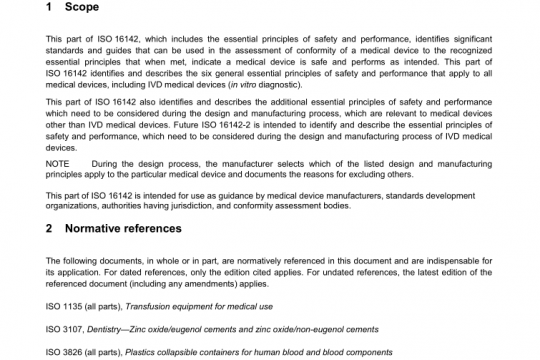AAMI TIR65 pdf free download
AAMI TIR65 pdf free download.Sustainability of medical devices—Elements of a responsible product life cycle.
4 Definitions For the purposes of this AAMI Technical Information Report, the following definitions apply. 4.1 chemicals of concern chemicals and/or substances that are identified by an authoritative agency (governmental or non-governmental organization (NGO)) that are known to cause harm to humans, animals, or the environment based on credible scientific evidence 4.2 cold chain storage and distribution activities of temperature sensitive products to ensure product integrity (examples may include temperature controlled containers and warehouses and/or insulated/refrigerated packaging) 4.3 cradle to cradle approach for assessing products beginning with raw material extraction and ending with reprocessing all raw materials until they are ready to be incorporated into a new product 4.4 cradle to grave approach for assessing products beginning with raw material extraction and ending with all material being returned to the earth 4.5 environmental life cycle assessment LCA environmental aspects and potential environmental impacts (e.g. use of resources and the environmental consequences of releases) throughout a product’s life cycle from raw material acquisition through production, use, end-of-life, treatment, recycling and final disposal (i.e. cradle to grave) 1 0 4.6 environmentally preferable product attribute product attribute that has been considered and found to be less damaging to the environment and/or human health when compared to competing product/service that serves the same purpose NOTE 1 to entry: Examples of environmentally preferable product attributes are described throughout Section 7, Environmental Sustainability. 4.7 environmentally preferable purchasing EPP act of purchasing products/services whose environmental impacts have been considered and found to be less damaging to the environment and human health when compared to competing products/services 1 1 4.8 green chemistry design of chemical products and processes that reduce or eliminate the use and generation of hazardous substances 1 2 4.9 hazardous waste waste that is dangerous or potentially harmful to our health or the environment Note 1 to entry: Hazardous wastes can be liquids, solids, gases, or sludges. They can be discarded commercial products, like cleaning fluids or pesticides, or the by-products of manufacturing processes. 1 3 4.10 medical device instrument, apparatus, implement, machine, contrivance, implant, in vitro reagent, or other similar or related article, including a component part, or accessory which is: recognized in the official National Formulary, or the United States Pharmacopoeia, or any supplement to them, intended for use in the diagnosis of disease or other conditions, or in the cure, mitigation, treatment, or prevention of disease, in man or other animals, or intended to affect the structure or any function of the body of man or other animals, and which does not achieve any of its primary intended purposes through chemical action within or on the body of man or other animals and which is not dependent upon being metabolized for the achievement of any of its primary intended purposes 4.11 nonrenewable resource natural resource that cannot be produced, regrown, or reused fast enough to keep up with how quickly it is used Note 1 to entry: Fossil fuels such as coal, oil, and natural gas, for example, take millions of years to develop naturally. 1 5 4.12 packaging system combination of the sterile barrier system (SBS) (for sterile product) and protective packaging 1 6 Note 1 to entry: The packaging system includes the SBS and the protective packaging. However, if the SBS protects the medical device, facilitates aseptic presentation, and is resilient enough not to require additional protective packaging, the SBS would also fulfil the requirements of a packaging system. Protective packaging is not always necessary however aseptic opening/presentation has to be ensured in all cases. 4.13 persistent, bioaccumulative, and toxic PBT chemicals that are toxic, persist in the environment and bioaccumulate in food chains and, thus, pose risks to human health and ecosystems 1 7 4.14 protective packaging configuration of materials designed to prevent damage to the SBS and its contents from the time of their assembly until the point of use 1 6 Note 1 to entry: National or regional regulations might require that protective packaging is used to avoid the potential contamination of the surgical environment. These regulations might also require that the protective packaging is removed prior to introduction of the SBS into the surgical environment.AAMI TIR65 pdf download.
Other IEC Standards
-

ANSI AAMI ISO 16142-1 pdf free download – non-IVD medical devices and guidance on the selection of standards
AAMI standards list DOWNLOAD -

ANSI AAMI ISO 16142-2 pdf free download – General essential principles and additional specifc essential principles
AAMI standards list DOWNLOAD


